phone TOYOTA TACOMA 2012 Owners Manual (in English)
[x] Cancel search | Manufacturer: TOYOTA, Model Year: 2012, Model line: TACOMA, Model: TOYOTA TACOMA 2012Pages: 628, PDF Size: 12.11 MB
Page 4 of 628

TABLE OF CONTENTSIndex
4
3-4. Using the hands-free phonesystem (for cellula r phone)
Hands-free phone system features ............................ 326
Using the hands-free phone system ................... 330
Making a phone call ........... 339
Setting a cellular phone...... 344
Security and system setup ................................ 350
Using the phone book ........ 355
3-5. Using the interior lights Interior lights list ................. 363
• Interior light ...................... 364
• Personal lights ................. 364
3-6. Using the storage features List of storage features....... 365
• Glove box .......................... 366
• Front console box ............ 366
• Cup holders ...................... 367
• Bottle holders ................... 369
• Auxiliary boxes ................. 370
• Overhead console ............ 372 3-7. Other interior features
Sun visors ........................... 373
Vanity mirrors ..................... 374
Clock................................... 375
Outside temperature display (vehicles with
auto anti-glare inside rear
view mirror) ....................... 376
Power outlets (12V DC) ...... 381
Power outlet (120V AC) ...... 382
Seatback table .................... 388
Floor mat ............................ 389
Luggage compartment features ............................ 391
Garage door opener ........... 400
Compass (vehicles with auto anti-glare inside rear
view mirror) ....................... 409
4-1. Maintenance and care Cleaning and protecting the vehicle exterior ........... 418
Cleaning and protecting the vehicle interior ............ 421
4-2. Maintenance Maintenance requirements .................... 424
General maintenance ......... 426
Emission inspection and maintenance (I/M)
programs .......................... 429
4Maintenance and care
Page 15 of 628
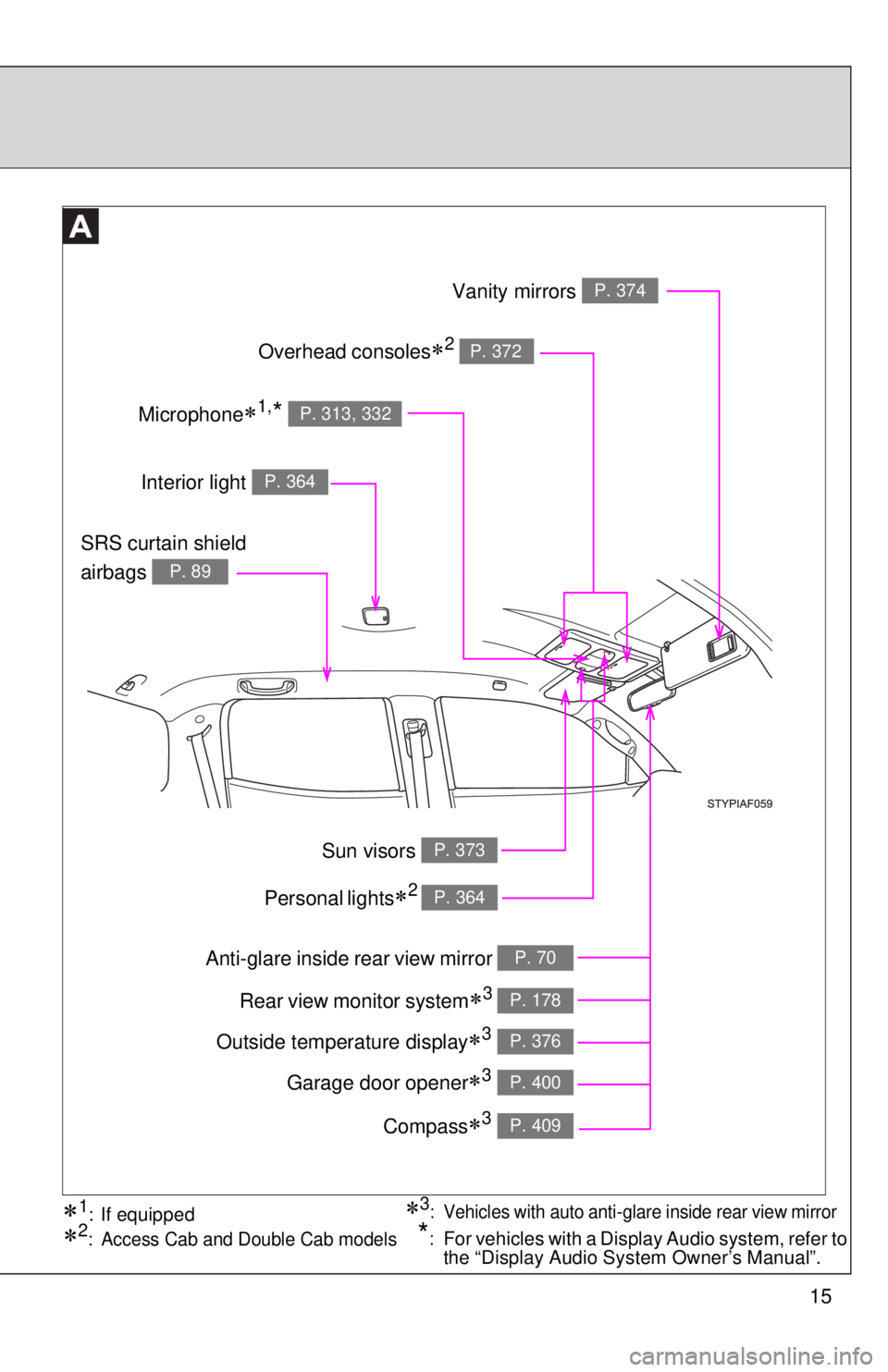
15
Anti-glare inside rear view mirror P. 70
SRS curtain shield
airbags
P. 89
Vanity mirrors P. 374
Interior light P. 364
Rear view monitor system3 P. 178
Overhead consoles2 P. 372
Garage door opener3 P. 400
Compass3 P. 409
Personal lights2 P. 364
Outside temperature display3 P. 376
3: Vehicles with auto anti-glare inside rear view mirror1: If equipped
2: Access Cab and Double Cab models*:For vehicles with a Display Audio system, refer to
the “Display Audio System Owner’s Manual”.
Microphone1,* P. 313, 332
Sun visors P. 373
Page 23 of 628
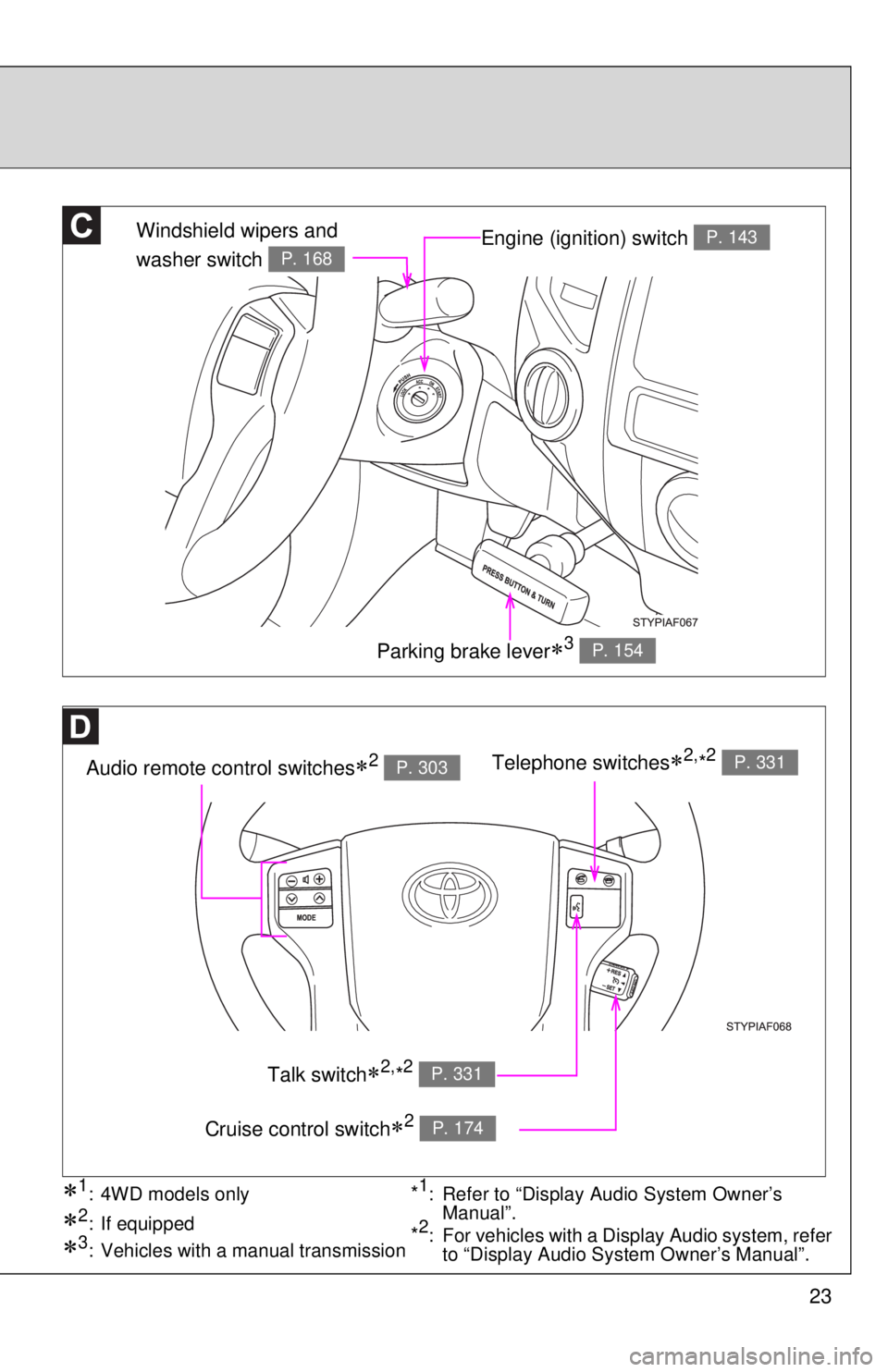
23
Engine (ignition) switch P. 143
Audio remote control switches2 P. 303
Windshield wipers and
washer switch
P. 168
Parking brake lever3 P. 154
Telephone switches2,*2 P. 331
Talk switch2,*2 P. 331
Cruise control switch2 P. 174
3: Vehicles with a manual transmission
1: 4WD models only
2: If equipped
*1: Refer to “Display Audio System Owner’s
Manual”.
*2: For vehicles with a Display Audio system, refer to “Display Audio System Owner’s Manual”.
Page 31 of 628

31
CAUTION
■General precautions while driving
Driving under the influence: Never drive your vehicle when under the influ-
ence of alcohol or drugs that have impaired your ability to operate your vehi-
cle. Alcohol and certain drugs delay reaction time, impair judgment and
reduce coordination, which could lead to an accident that could result in
death or serious injury.
Defensive driving: Always drive defensively. Anticipate mistakes that other
drivers or pedestrians might make and be ready to avoid accidents.
Driver distraction: Always give your full attention to driving. Anything that dis-
tracts the driver, such as adjusting controls, talking on a cellular phone or
reading can result in a collision with resulting death or serious injury to you,
your occupants or others.
■ General precaution regarding children’s safety
Never leave children unattended in the vehicle, and never allow children to
have or use the key.
Children may be able to start the vehicle or shift the vehicle into neutral.
There is also a danger that children may injure themselves by playing with
the windows, or other features of the vehicle. In addition, heat build-up or
extremely cold temperatures inside the vehicle can be fatal to children.
Page 37 of 628

37
1-2. Opening, closing and locking the doors
1
Before driving
■
Wireless remote control depletion
The standard battery life is 1 to 2 years. (The battery becomes depleted
even if the key is not used.) If the wireless remote control function does not
operate, the battery may be depleted. Replace the battery when necessary.
(P. 472)
■ If the wireless remote control does not operate
Locking and unlocking the doors: Use the key. ( P. 39)
■ Security feature
If a door is not opened within approximately 30 seconds after the vehicle is
unlocked, the security feature automatically locks the vehicle again.
■ Conditions affecting operation
The wireless remote control function may not operate normally in the follow-
ing situations.
●Near a TV tower, radio station, electr ic power plant, airport or other facil-
ity that generates strong radio waves
● When carrying a portable radio, cell ular phone or other wireless commu-
nication device
● When multiple wireless keys are in the vicinity
● When the wireless key has come into contact with, or is covered by a
metallic object
● When a wireless key (that emits radio waves) is being used nearby
● When the wireless key has been left near an electrical appliance such as
a personal computer
■ When riding in an aircraft
When bringing a wireless remote control onto an aircraft, make sure you do
not press any buttons on the wireless remote control while inside the aircraft
cabin. If you are carrying a wireless remote control in your bag etc, ensure
that the buttons are not likely to be pressed accidentally. Pressing a button
may cause the wireless remote control to emit radio waves that could inter-
fere with the operation of the aircraft.
■ Customization that can be co nfigured at Toyota dealer
Settings (e.g. wireless remote control system) can be changed.
(Customizable features P. 583)
Page 246 of 628
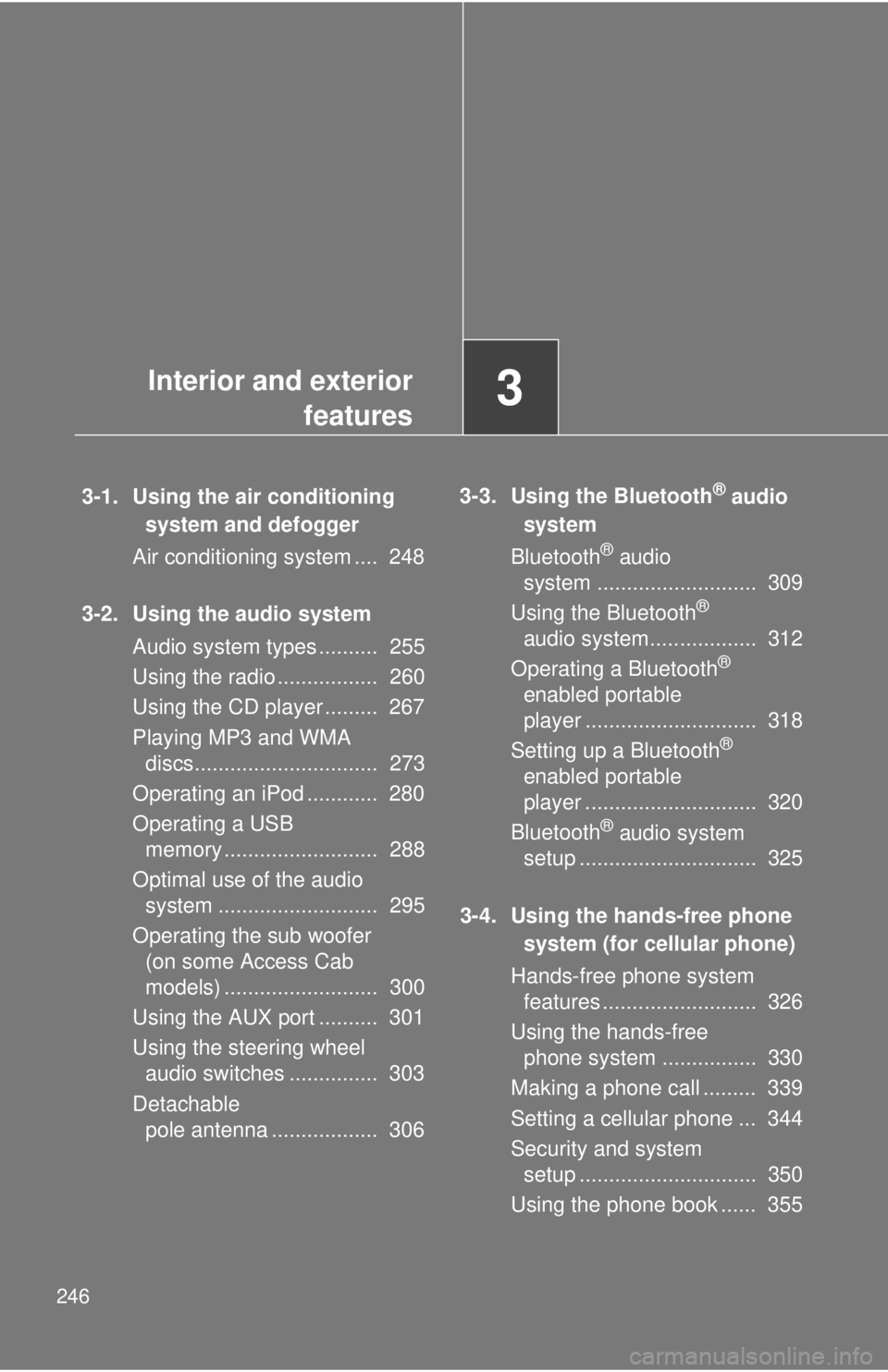
246
3-1. Using the air conditioningsystem and defogger
Air conditioning system .... 248
3-2. Using the audio system Audio system types .......... 255
Using the radio ................. 260
Using the CD player ......... 267
Playing MP3 and WMA discs............................... 273
Operating an iPod ............ 280
Operating a USB memory .......................... 288
Optimal use of the audio system ........................... 295
Operating the sub woofer (on some Access Cab
models) .......................... 300
Using the AUX port .......... 301
Using the steering wheel audio switches ............... 303
Detachable pole antenna .................. 306 3-3. Using the Bluetooth® audio
system
Bluetooth
® audio
system ........................... 309
Using the Bluetooth
®
audio system.................. 312
Operating a Bluetooth
®
enabled portable
player ............................. 318
Setting up a Bluetooth
®
enabled portable
player ............................. 320
Bluetooth
® audio system
setup .............................. 325
3-4. Using the hands-free phone system (for cellular phone)
Hands-free phone system features .......................... 326
Using the hands-free phone system ................ 330
Making a phone call ......... 339
Setting a cellular phone ... 344
Security and system setup .............................. 350
Using the phone book ...... 355
Interior and exterior features3
Page 257 of 628
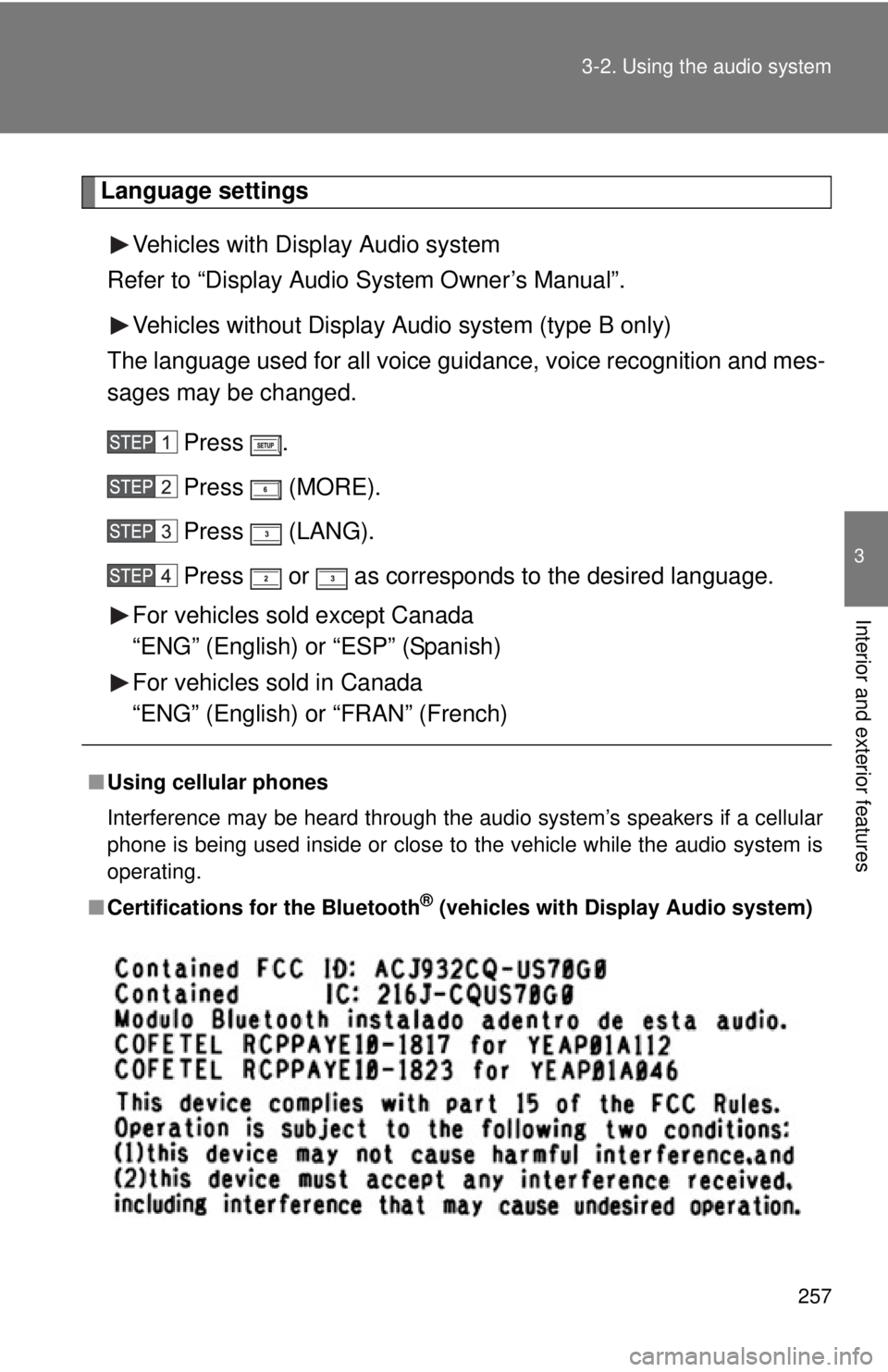
257
3-2. Using the audio system
3
Interior and exterior features
Language settings
Vehicles with Display Audio system
Refer to “Display Audio System Owner’s Manual”.
Vehicles without Display Audio system (type B only)
The language used for all voice guidance, voice recognition and mes-
sages may be changed.
Press .
Press (MORE).
Press (LANG).
Press or as corresponds to the desired language.
For vehicles sold except Canada
“ENG” (English) or “ESP” (Spanish)
For vehicles sold in Canada
“ENG” (English) or “FRAN” (French)
■ Using cellular phones
Interference may be heard through the audio system’s speakers if a cellular
phone is being used inside or close to the vehicle while the audio syste\
m is
operating.
■ Certifications for the Bluetooth
® (vehicles with Display Audio system)
Page 286 of 628
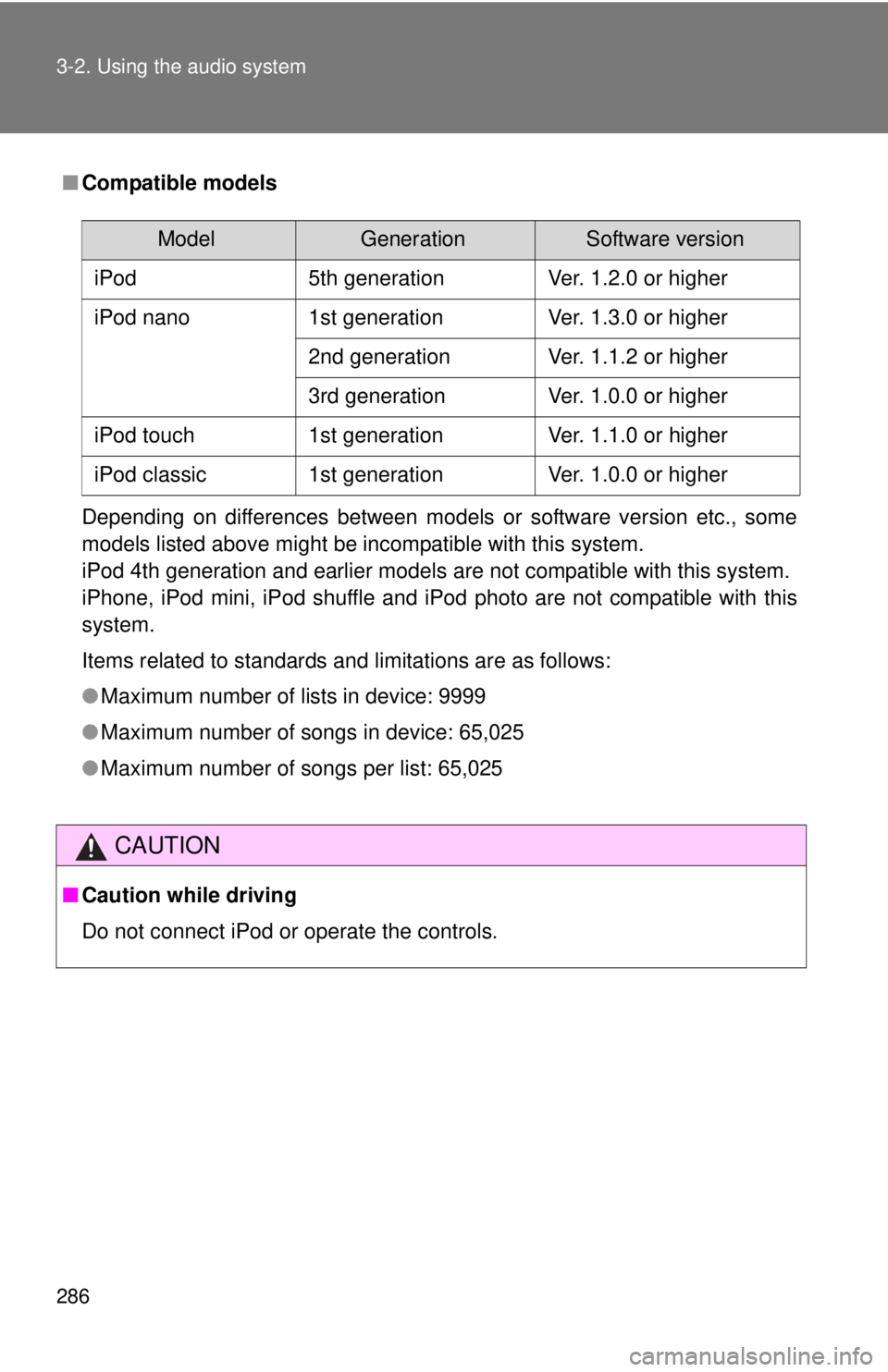
286 3-2. Using the audio system
■Compatible models
Depending on differences between models or software version etc., some
models listed above might be incompatible with this system.
iPod 4th generation and earlier models are not compatible with this system.
iPhone, iPod mini, iPod shuffle and iPod photo are not compatible with this
system.
Items related to standards and limitations are as follows:
●Maximum number of lists in device: 9999
● Maximum number of songs in device: 65,025
● Maximum number of songs per list: 65,025
CAUTION
■Caution while driving
Do not connect iPod or operate the controls.
ModelGenerationSoftware version
iPod 5th generation Ver. 1.2.0 or higher
iPod nano 1st generation Ver. 1.3.0 or higher
2nd generation Ver. 1.1.2 or higher
3rd generation Ver. 1.0.0 or higher
iPod touch 1st generation Ver. 1.1.0 or higher
iPod classic 1st generation Ver. 1.0.0 or higher
Page 313 of 628
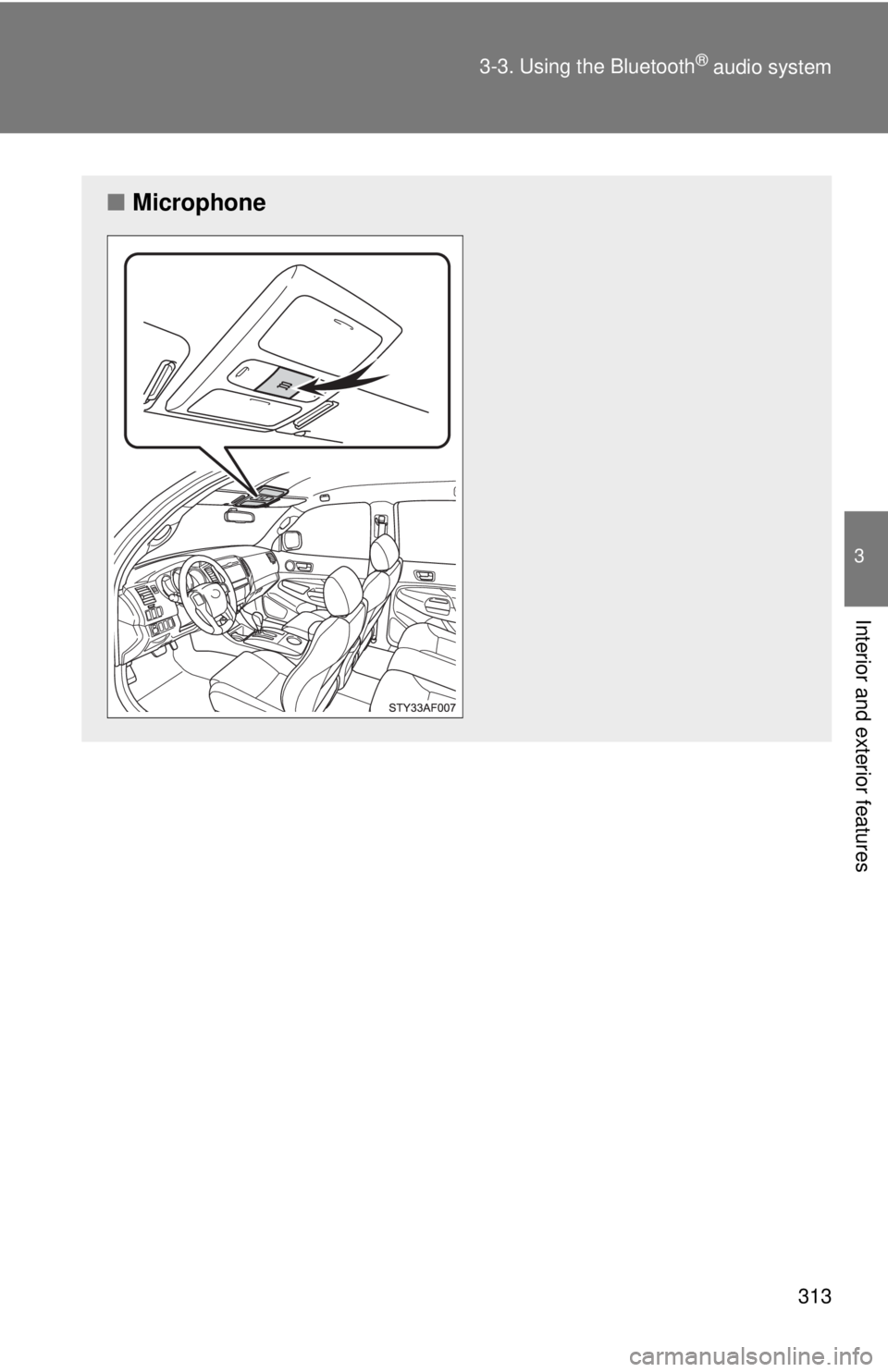
313
3-3. Using the Bluetooth
® audio system
3
Interior and exterior features
■
Microphone
Page 315 of 628
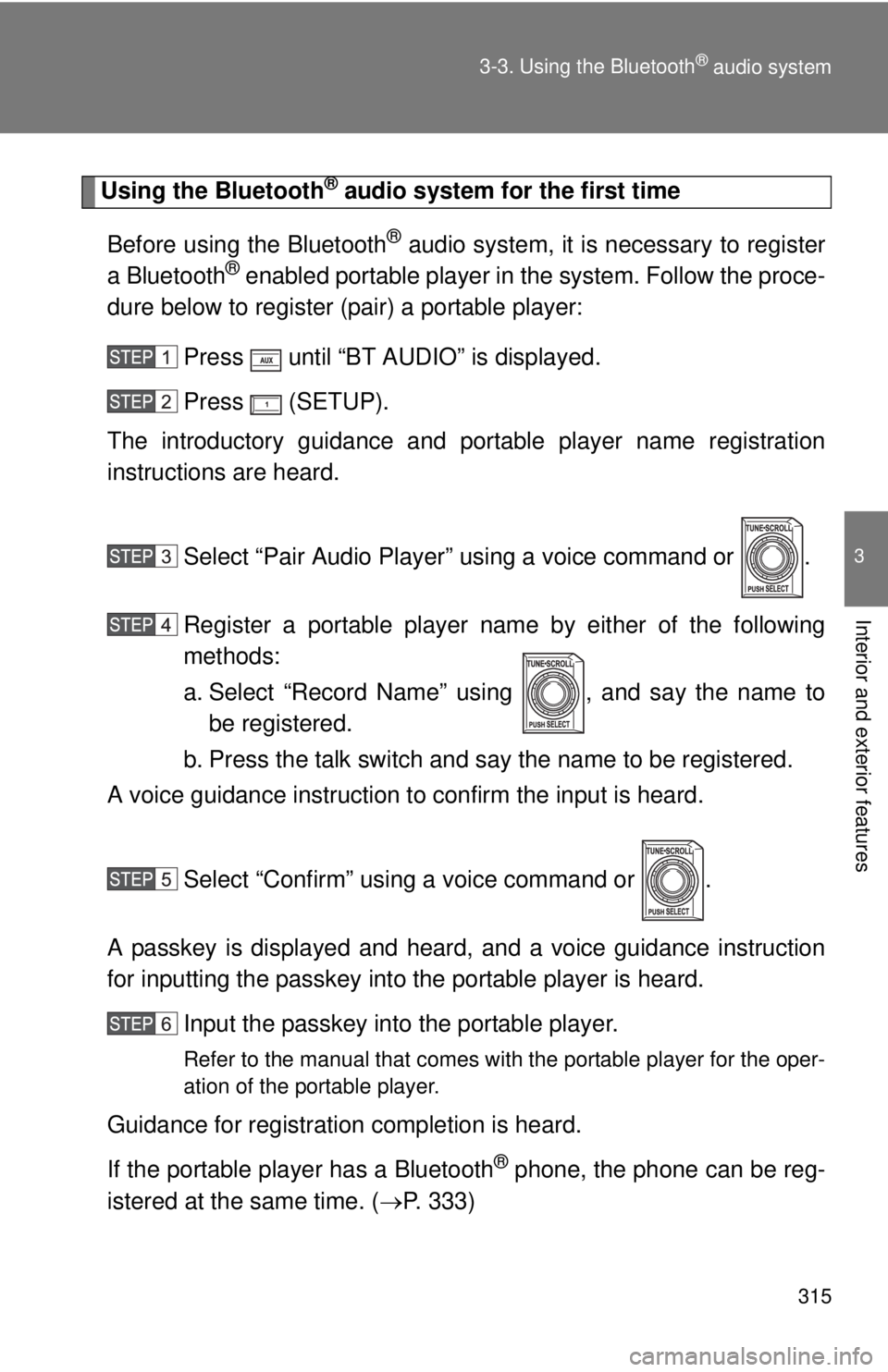
315
3-3. Using the Bluetooth
® audio system
3
Interior and exterior features
Using the Bluetooth® audio system for the first time
Before using the Bluetooth
® audio system, it is necessary to register
a Bluetooth® enabled portable player in the system. Follow the proce-
dure below to register (pair) a portable player:
Press until “BT AUDIO” is displayed.
Press (SETUP).
The introductory guidance and port able player name registration
instructions are heard.
Select “Pair Audio Player” using a voice command or .
Register a portable player nam e by either of the following
methods:
a. Select “Record Name” using , and say the name to be registered.
b. Press the talk switch and say the name to be registered.
A voice guidance instruction to confirm the input is heard.
Select “Confirm” using a voice command or .
A passkey is displayed and heard, and a voice guidance instruction
for inputting the passkey into the portable player is heard. Input the passkey into the portable player.
Refer to the manual that comes with the portable player for the oper-
ation of the portable player.
Guidance for registration completion is heard.
If the portable player has a Bluetooth
® phone, the phone can be reg-
istered at the same time. ( P. 333)